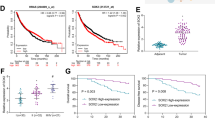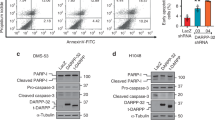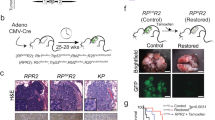Abstract
Cyclooxygenase-2 (COX-2) is frequently overexpressed in human cancers and contributes to the malignant phenotype. Our data indicate unphosphorylated signal transducers and activators of transcription 6 (STAT6) may transcriptionally upregulate COX-2 expression and protect against apoptosis in NSCLC cells. In A427 and H2122, NSCLC cell lines that constitutively express COX-2, only unphosphorylated STAT6 was detectable by western blot, thus, all of the following STAT6-dependent effects are attributed to the unphosphorylated protein. In both cell lines, small-interfering RNA-mediated knockdown of STAT6 or stable expression of dominant-negative STAT6 decreased COX-2 expression. In contrast, transfection with a phosphorylation-deficient mutant STAT6 increased COX-2 levels. Immunofluorescent staining revealed the presence of STAT6 in H2122 nuclei, suggesting a direct role in gene regulation for the unphosphorylated protein. Consistent with this hypothesis, unphosphorylated STAT6 increased luciferase expression from a COX-2 promoter reporter construct. STAT6 co-immunoprecipitated with the transcriptional co-activator, p300, and chromatin immunoprecipitation assays demonstrated that these proteins bind a consensus STAT6 binding site located within the COX-2 promoter. STAT6 DNA-binding specificity was confirmed by electrophoretic mobility shift assay. As COX-2 over-expression has been clearly linked to apoptosis resistance and other hallmarks of malignancy, these findings suggest a novel role of unphosphorylated STAT6 in the pathogenesis of non-small cell lung cancer.
This is a preview of subscription content, access via your institution
Access options
Subscribe to this journal
Receive 50 print issues and online access
$259.00 per year
only $5.18 per issue
Buy this article
- Purchase on Springer Link
- Instant access to full article PDF
Prices may be subject to local taxes which are calculated during checkout







Similar content being viewed by others
References
Bhattacharya S, Schindler C . (2003). Regulation of Stat3 nuclear export. J Clin Invest 111: 553–559.
Chatterjee-Kishore M, Wright KL, Ting JP, Stark GR . (2000). How Stat1 mediates constitutive gene expression: a complex of unphosphorylated Stat1 and IRF1 supports transcription of the LMP2 gene. EMBO J 19: 4111–4122.
Chattopadhyay S, Machado-Pinilla R, Manguan-Garcia C, Belda-Iniesta C, Moratilla C, Cejas P et al. (2006). MKP1/CL100 controls tumor growth and sensitivity to cisplatin in non-small-cell lung cancer. Oncogene 25: 3335–3345.
Deng WG, Zhu Y, Wu KK . (2004). Role of p300 and PCAF in regulating cyclooxygenase-2 promoter activation by inflammatory mediators. Blood 103: 2135–2142.
Dohadwala M, Batra RK, Luo J, Lin Y, Krysan K, Pold M et al. (2002). Autocrine/paracrine prostaglandin E2 production by non-small cell lung cancer cells regulates matrix metalloproteinase-2 and CD44 in cyclooxygenase-2-dependent invasion. J Biol Chem 277: 50828–50833.
Gagarin D, Yang Z, Butler J, Wimmer M, Du B, Cahan P et al. (2005). Genomic profiling of acquired resistance to apoptosis in cells derived from human atherosclerotic lesions: potential role of STATs, cyclinD1, BAD, and Bcl-XL. J Mol Cell Cardiol 39: 453–465.
Galka E, Thompson JL, Zhang WJ, Poritz LS, Koltun WA . (2004). Stat6 (null phenotype) human lymphocytes exhibit increased apoptosis. J Surg Res 122: 14–20.
Gingras S, Simard J, Groner B, Pfitzner E . (1999). p300/CBP is required for transcriptional induction by interleukin-4 and interacts with Stat6. Nucleic Acids Res 27: 2722–2729.
Herschman HR . (1999). Function and regulation of prostaglandin synthase 2. Adv Exp Med Biol 469: 3–8.
Hou J, Schindler U, Henzel WJ, Ho TC, Brasseur M, McKnight SL . (1994). An interleukin-4-induced transcription factor: IL-4 Stat. Science 265: 1701–1706.
Kotanides H, Reich NC . (1993). Requirement of tyrosine phosphorylation for rapid activation of a DNA binding factor by IL-4. Science 262: 1265–1267.
Krysan K, Dalwadi H, Sharma S, Pold M, Dubinett SM . (2004). Cyclooxygenase 2-dependent expression of survivin is critical for apoptosis resistance in non-small cell lung cancer. Cancer Res 64: 6359–6362.
Kumar A, Commane M, Flickinger TW, Horvath CM, Stark GR . (1997). Defective TNF-alpha-induced apoptosis in STAT1-null cells due to low constitutive levels of caspases. Science 278: 1630–1632.
Leonard WJ, O'Shea JJ . (1998). Jaks and STATs: biological implications. Annu Rev Immunol 16: 293–322.
McDonald C, Reich NC . (1999). Cooperation of the transcriptional coactivators CBP and p300 with Stat6. J Interferon Cytokine Res 19: 711–722.
Meyer T, Gavenis K, Vinkemeier U . (2002). Cell type-specific and tyrosine phosphorylation-independent nuclear presence of STAT1 and STAT3. Exp Cell Res 272: 45–55.
Mikita T, Campbell D, Wu P, Williamson K, Schindler U . (1996). Requirements for interleukin-4-induced gene expression and functional characterization of Stat6. Mol Cell Biol 16: 5811–5820.
Pold M, Zhu LX, Sharma S, Burdick MD, Lin Y, Lee PP et al. (2004). Cyclooxygenase-2-dependent expression of angiogenic CXC chemokines ENA-78/CXC Ligand (CXCL) 5 and interleukin-8/CXCL8 in human non-small cell lung cancer. Cancer Res 64: 1853–1860.
Schindler C, Kashleva H, Pernis A, Pine R, Rothman P . (1994). STF-IL-4: a novel IL-4-induced signal transducing factor. EMBO J 13: 1350–1356.
Sheng H, Shao J, Morrow JD, Beauchamp RD, DuBois RN . (1998). Modulation of apoptosis and Bcl-2 expression by prostaglandin E2 in human colon cancer cells. Cancer Res 58: 362–366.
Shikama N, Lyon J, La Thangue NB . (1997). The p300/CBP family: integrating signals with transcription factors and chromatin. Trends Cell Biol 7: 230–236.
Stolina M, Sharma S, Lin Y, Dohadwala M, Gardner B, Luo J et al. (2000). Specific inhibition of cyclooxygenase 2 restores antitumor reactivity by altering the balance of IL-10 and IL-12 synthesis. J Immunol 164: 361–370.
Wang D, Lippard SJ . (2005). Cellular processing of platinum anticancer drugs. Nat Rev Drug Discov 4: 307–320.
Yang J, Chatterjee-Kishore M, Staugaitis SM, Nguyen H, Schlessinger K, Levy DE et al. (2005). Novel roles of unphosphorylated STAT3 in oncogenesis and transcriptional regulation. Cancer Res 65: 939–947.
Zeng R, Aoki Y, Yoshida M, Arai K, Watanabe S . (2002). Stat5B shuttles between cytoplasm and nucleus in a cytokine-dependent and -independent manner. J Immunol 168: 4567–4575.
Zhang M, Zhou Y, Xie C, Zhou F, Chen Y, Han G et al. (2005). STAT6 specific shRNA inhibits proliferation and induces apoptosis in colon cancer HT-29 cells. Cancer Lett 243: 38–46.
Acknowledgements
We thank Dr Katherine Peebles for reviewing the manuscript. This work was supported by University of California at Los Angeles Specialized Program of Research Excellence In Lung Cancer NIH grant P50 CA90388, UC Tobacco-Related Disease Research Program 13RT-0031, NIH RO1 CA111851 and Merit Review Research Funds from the Department of Veterans Affairs.
Author information
Authors and Affiliations
Corresponding author
Additional information
Supplementary Information accompanies the paper on the Oncogene website (http://www.nature.com/onc).
Supplementary information
Rights and permissions
About this article
Cite this article
Cui, X., Zhang, L., Luo, J. et al. Unphosphorylated STAT6 contributes to constitutive cyclooxygenase-2 expression in human non-small cell lung cancer. Oncogene 26, 4253–4260 (2007). https://doi.org/10.1038/sj.onc.1210222
Received:
Revised:
Accepted:
Published:
Issue Date:
DOI: https://doi.org/10.1038/sj.onc.1210222
Keywords
This article is cited by
-
Autosomal Dominant STAT6 Gain of Function Causes Severe Atopy Associated with Lymphoma
Journal of Clinical Immunology (2023)
-
STAT proteins: a kaleidoscope of canonical and non-canonical functions in immunity and cancer
Journal of Hematology & Oncology (2021)
-
The Expression Levels of IL-4/IL-13/STAT6 Signaling Pathway Genes and SOCS3 Could Help to Differentiate the Histopathological Subtypes of Non-Small Cell Lung Carcinoma
Molecular Diagnosis & Therapy (2018)
-
Role of Cyclooxygenase-2 on Intermittent Hypoxia-Induced Lung Tumor Malignancy in a Mouse Model of Sleep Apnea
Scientific Reports (2017)
-
p300 Exerts an Epigenetic Role in Chronic Neuropathic Pain through its Acetyltransferase Activity in Rats following Chronic Constriction Injury (CCI)
Molecular Pain (2012)



